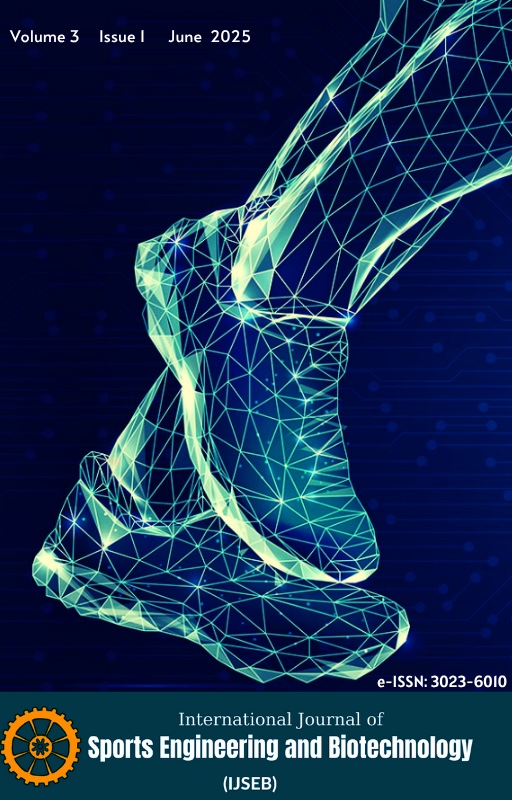Comparative Analysis of Aerobic Capacity (Vo2max) Between University-Level Judo and Football Players
DOI:
https://doi.org/10.5281/zenodo.15752629Keywords:
Aerobic Capacity , Football , Judo, VO2MaxAbstract
Aerobic capacity, measured by VO2max, is a key indicator of cardiovascular efficiency and endurance, essential for athletic performance. Football primarily involves sustained aerobic activity, whereas judo combines aerobic demands with high-intensity anaerobic bursts. This study aimed to compare VO2 max levels between university-level football and judo players, highlighting differences in cardiovascular endurance across these sports. A total of 60 male athletes (football = 30; judo = 30) from the University of Delhi participated in the study. All participants were aged between 18 to 24 years and had participated at the inter-university level. VO2 max was estimated using the Cooper 12-Minute Run Test. Descriptive statistics and a t-test were conducted to compare the groups. The analysis revealed that football players exhibited significantly higher VO2max values compared to judo players (p < 0.05). This finding aligns with the distinct physiological requirements of the sports: football demands prolonged aerobic activity, while judo emphasizes intermittent anaerobic effort with recovery phases predominated by muscular endurance. This study highlights significant differences in VO2max between football and judo players, with football players demonstrating superior aerobic capacity. The findings emphasize the importance of sport-specific demands in evaluating cardiovascular endurance and offer insights for optimizing training programs for different athletic disciplines.
References
Jabeen, M., Surwase, S. P., Shete, A. N., & Jadhav, R. (2020). Comparative study of aerobic and anaerobic capacity in football players and judo players. IOSR Journal of Dental and Medical Sciences, 19(2), 41–47. [CrossRef]
Srivastava, S., Tamrakar, S., Nallathambi, N., Vrindavanam, S. A., Prasad, R., & Kothari, R. (2020). Assessment of maximal oxygen uptake (VO2 max) in athletes and non-athletes assessed in sports physiology laboratory. Cureus. [CrossRef]
Podlogar, T., Leo, P., & Spragg, J. (2022). Using VO2max as a marker of training status in athletes—Can we do better? Journal of Applied Physiology, 133(1), 144–147. [CrossRef]
Buttar, K. K., Saboo, N., & Kacker, S. (2019). A review: Maximal oxygen uptake (VO2 max) and its estimation methods. International Journal of Physical Education, Sports and Health, 6(6), 24-32. [CrossRef]
Åstrand, P.-O., & Rodahl, K. (2000). Textbook of work physiology: Physiological bases of exercise. McGraw-Hill.
Dugas, M.-O., Paradis-Deschênes, P., Simard, L., Chevrette, T., Blackburn, P., & Lavallière, M. (2023). Comparison of VO2max estimations for maximal and submaximal exercise tests in apparently healthy adults. Sports, 11(12), 235. [CrossRef]
Bandyopadhyay, A. (2014). Validity of Cooper’s 12-minute run test for estimation of maximum oxygen uptake in male university students. Biology of Sport, 32(1), 59–63. [CrossRef]
Alvarez-Ramirez, J., & Rodriguez, E. (2021). Theoretical analysis of the 12 min Cooper’s test to estimate the maximal oxygen uptake rate. Biomedical Signal Processing and Control, 69, 102885. [CrossRef]
Shephard, R. J. (1984). Tests of maximum oxygen intake: A critical review. Sports Medicine, 1(2), 99–124. [CrossRef]
Andreoli, A., Melchiorri, G., Brozzi, M., Di Marco, A., Volpe, S. L., Garofano, P., Daniele, N. D., & De Lorenzo, A. (2003). Effect of different sports on body cell mass in highly trained athletes. Acta Diabetologica, 40(S1), s122–s125. [CrossRef]
Krustrup, P., & Bangsbo, J. (2001). Physiological demands of top-class soccer refereeing in relation to physical capacity: Effect of intense intermittent exercise training. Journal of Sports Sciences, 19(11), 881–891. [CrossRef]
Buchheit, M., & Laursen, P. B. (2013). High-intensity interval training: Solutions to the programming puzzle. Sports Medicine, 43(5), 313–338. [CrossRef]
Katralli, J. & Goudar, S. S. (2012). Anthropometric profile and special judo fitness levels of Indian judo players. Asian Journal of Sports Medicine, 3(2), 113–118. [CrossRef]
Julio, U. F., Panissa, V. L. G., Esteves, J. V., Cury, R. L., Agostinho, M. F., & Franchini, E. (2017). Energy-system contributions to simulated judo matches. International Journal of Sports Physiology and Performance, 12(5), 676–683. [CrossRef]
Mohammed, M. H. H., & Choi, H. J. (2017). Effect of an 8-week judo course on muscular endurance, trunk flexibility, and explosive strength of male university students. Sport Mont, 15(3), 51-53. [CrossRef]
Chahal, M. & Hooda, D. (2015). Aerobic and anaerobic capacity of track and field athletes: A comparative study. International Journal of Physical Education, Sports and Health, 2(2). [CrossRef]
Triki, M., Rebai, H., Shamssain, M., Masmoudi, K., Fellmann, N., Zouari, H., Zouari, N., & Tabka, Z. (2013). Comparative study of aerobic performance between football and judo groups in prepubertal boys. Asian Journal of Sports Medicine, 4(3), 165–174. [CrossRef]
Downloads
Published
How to Cite
Issue
Section
License
Copyright (c) 2025 Sagar SINGH, Rabiya HUSAIN, Dhananjoy SHAW

This work is licensed under a Creative Commons Attribution 4.0 International License.



